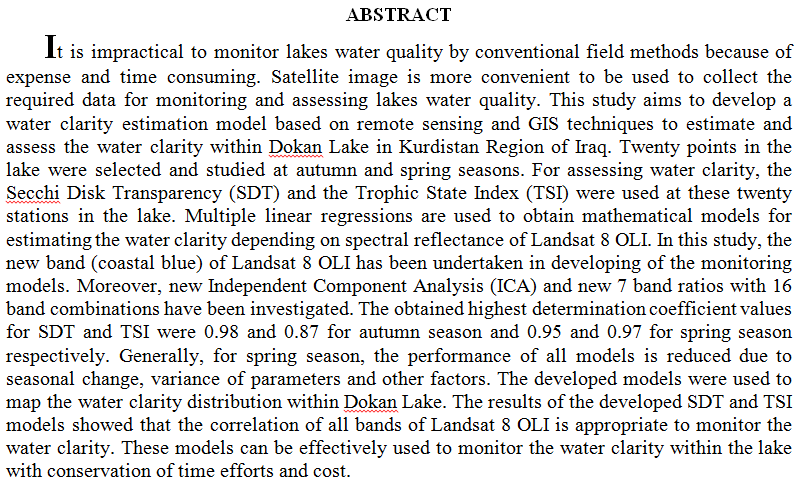
In this study, the hydromorphodynamic simulation of a stretch of the Euphrates River was conducted. The stretch of the Euphrates River extended from Haditha dam to the city of Heet in Al-Anbar Governorate and it is estimated to be 124.4 km. Samples were taken from 3 sites along the banks of the river stretch using sampling equipment. The samples were taken to the laboratory for grain size analysis where the median size (D50) and sediment load were determined. The hydromorphodynamic simulation was conducted using the NACY 2DH solver of the iRIC model. The model was calibration using the Manning roughness, sediment load, and median particle size and the validation process showed that the error between th
... Show MoreIn this study, the nanocrystal-ZnS-loaded graphene was synthesized by a facile coprecipitation route. The effect of graphene on the characterization of Zinc Sulphide (ZnS) was investigated. The X-ray Diffraction (XRD) results reveal that ZnS has cubic system while hexagonal structure which is observed by loading graphene during the preparation of ZnS. Energy Dispersive X-ray Spectroscopy (EDS) analysis proved the presence of all expected elements in the prepared materials. Nanosize of fabricated materials has been measured using Scanning Electron Microscopy (SEM) technique. This study also found that the graphene plays a critical role in lowering the optical energy gap of ZnS nanoparticles from 4 eV to 3.2 eV. The characterization of detec
... Show More (2)
(2)
Background: Tap waters play an important role in fulfilling the people needs for drinking and domestic purposes. Contaminate the tap water with different pollutants has become an issue of great concern for 90% of people who are depended on the tap water as the main source of drinking. Pollutants can make their way easily into the delivering pipes which suffer from the leaking resulting in decreasing the quality of water. Objective: Therefore, assess the water quality for drinking purpose by calculating the water quality index is an important tool to ascertain whether the water is suitable for human consumption or not. Methods: In the present work, the water quality of the Al-Salam, western region of Baghdad city, Iraq was investigated for 7
... Show More (5)
(5)
Most vegetation’s are Land cover (LC) for the globe, and there is an increased attention to plants since they represent an element of balance to natural ecology and maintain the natural balance of rapid changes due to systematic and random human uses, including the subject of the current study (Bassia eriophora ) Which represent an essential part of the United Nations system for land cover classification (LCCS), developed by the World Food Organization (FAO) and the world Organization for environmental program (UNEP), to observe basic environmental elements with modern techniques. Although this plant is distributed all over Iraq, we found that this plant exists primarily in the middle
... Show More (17)
(17)
 (6)
(6)
 (5)
(5)
Copper Telluride Thin films of thickness 700nm and 900nm, prepared thin films using thermal evaporation on cleaned Si substrates kept at 300K under the vacuum about (4x10-5 ) mbar. The XRD analysis and (AFM) measurements use to study structure properties. The sensitivity (S) of the fabricated sensors to NO2 and H2 was measured at room temperature. The experimental relationship between S and thickness of the sensitive film was investigated, and higher S values were recorded for thicker sensors. Results showed that the best sensitivity was attributed to the Cu2Te film of 900 nm thickness at the H2 gas.
 (5)
(5)
Water quality planning relies on Biochemical Oxygen Demand BOD. BOD testing takes five days. The Particle Swarm Optimization (PSO) is increasingly used for water resource forecasting. This work designed a PSO technique for estimating everyday BOD at Al-Rustumiya wastewater treatment facility inlet. Al-Rustumiya wastewater treatment plant provided 702 plant-scale data sets during 2012-2022. The PSO model uses the daily data of the water quality parameters, including chemical oxygen demand (COD), chloride (Cl-), suspended solid (SS), total dissolved solids (TDS), and pH, to determine how each variable affects the daily incoming BOD. PSO and multiple linear regression (MLR) findings are compared, and their perfor
... Show MoreWater quality planning relies on Biochemical Oxygen Demand BOD. BOD testing takes five days. The Particle Swarm Optimization (PSO) is increasingly used for water resource forecasting. This work designed a PSO technique for estimating everyday BOD at Al-Rustumiya wastewater treatment facility inlet. Al-Rustumiya wastewater treatment plant provided 702 plant-scale data sets during 2012-2022. The PSO model uses the daily data of the water quality parameters, including chemical oxygen demand (COD), chloride (Cl-), suspended solid (SS), total dissolved solids (TDS), and pH, to determine how each variable affects the daily incoming BOD. PSO and multiple linear regression (MLR) findings are compared, and their performance is evaluated usin
... Show MoreBackground: The marginal seal is essential for sealant success because penetration of bacteria under the sealant might allow caries onset or progression. The aim of the present study was to estimate and compare the microleakage of pit and fissure sealant after various methods of occlusal surface preparation. Materials and methods: Thirty non-carious premolars extracted for orthodontic reasons were equally divided into three groups. In group one, occlusal fissures were opened with round carbide bur, in group two, occlusal surfaces of the teeth were cleaned with a dry pointed bristle brush and samples of group three were cleaned with a slurry of fine flour of pumice in water using rubber cup. Then fissures of all teeth were etched using 35% p
... Show MoreKE Sharquie, AA Noaimi, HA Al-Mudaris, Journal of Cosmetics, Dermatological Sciences and Applications, 2013 - Cited by 4
